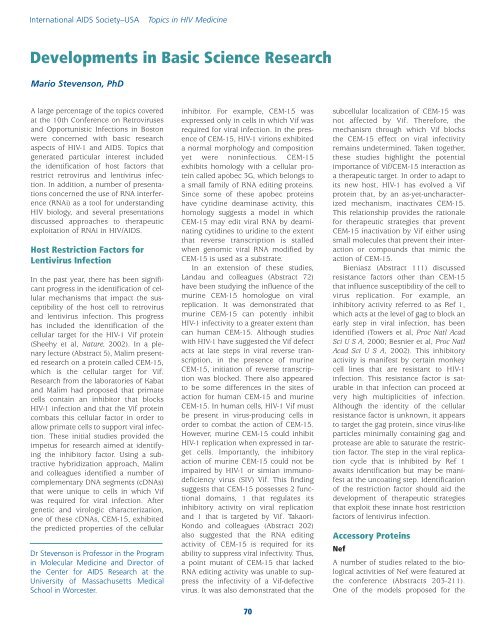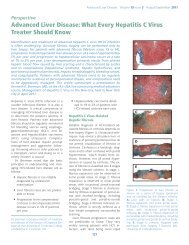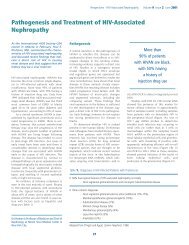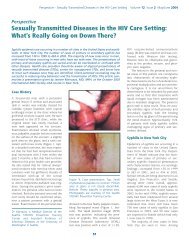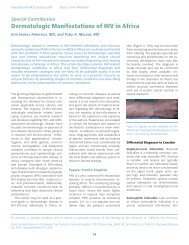Topics in HIV Medicine® - International AIDS Society-USA
Topics in HIV Medicine® - International AIDS Society-USA
Topics in HIV Medicine® - International AIDS Society-USA
Create successful ePaper yourself
Turn your PDF publications into a flip-book with our unique Google optimized e-Paper software.
<strong>International</strong> <strong>AIDS</strong> <strong>Society</strong>–<strong>USA</strong><br />
<strong>Topics</strong> <strong>in</strong> <strong>HIV</strong> Medic<strong>in</strong>e<br />
Developments <strong>in</strong> Basic Science Research<br />
Mario Stevenson, PhD<br />
A large percentage of the topics covered<br />
at the 10th Conference on Retroviruses<br />
and Opportunistic Infections <strong>in</strong> Boston<br />
were concerned with basic research<br />
aspects of <strong>HIV</strong>-1 and <strong>AIDS</strong>. <strong>Topics</strong> that<br />
generated particular <strong>in</strong>terest <strong>in</strong>cluded<br />
the identification of host factors that<br />
restrict retrovirus and lentivirus <strong>in</strong>fection.<br />
In addition, a number of presentations<br />
concerned the use of RNA <strong>in</strong>terference<br />
(RNAi) as a tool for understand<strong>in</strong>g<br />
<strong>HIV</strong> biology, and several presentations<br />
discussed approaches to therapeutic<br />
exploitation of RNAi <strong>in</strong> <strong>HIV</strong>/<strong>AIDS</strong>.<br />
Host Restriction Factors for<br />
Lentivirus Infection<br />
In the past year, there has been significant<br />
progress <strong>in</strong> the identification of cellular<br />
mechanisms that impact the susceptibility<br />
of the host cell to retrovirus<br />
and lentivirus <strong>in</strong>fection. This progress<br />
has <strong>in</strong>cluded the identification of the<br />
cellular target for the <strong>HIV</strong>-1 Vif prote<strong>in</strong><br />
(Sheehy et al, Nature, 2002). In a plenary<br />
lecture (Abstract 5), Malim presented<br />
research on a prote<strong>in</strong> called CEM-15,<br />
which is the cellular target for Vif.<br />
Research from the laboratories of Kabat<br />
and Malim had proposed that primate<br />
cells conta<strong>in</strong> an <strong>in</strong>hibitor that blocks<br />
<strong>HIV</strong>-1 <strong>in</strong>fection and that the Vif prote<strong>in</strong><br />
combats this cellular factor <strong>in</strong> order to<br />
allow primate cells to support viral <strong>in</strong>fection.<br />
These <strong>in</strong>itial studies provided the<br />
impetus for research aimed at identify<strong>in</strong>g<br />
the <strong>in</strong>hibitory factor. Us<strong>in</strong>g a subtractive<br />
hybridization approach, Malim<br />
and colleagues identified a number of<br />
complementary DNA segments (cDNAs)<br />
that were unique to cells <strong>in</strong> which Vif<br />
was required for viral <strong>in</strong>fection. After<br />
genetic and virologic characterization,<br />
one of these cDNAs, CEM-15, exhibited<br />
the predicted properties of the cellular<br />
Dr Stevenson is Professor <strong>in</strong> the Program<br />
<strong>in</strong> Molecular Medic<strong>in</strong>e and Director of<br />
the Center for <strong>AIDS</strong> Research at the<br />
University of Massachusetts Medical<br />
School <strong>in</strong> Worcester.<br />
<strong>in</strong>hibitor. For example, CEM-15 was<br />
expressed only <strong>in</strong> cells <strong>in</strong> which Vif was<br />
required for viral <strong>in</strong>fection. In the presence<br />
of CEM-15, <strong>HIV</strong>-1 virions exhibited<br />
a normal morphology and composition<br />
yet were non<strong>in</strong>fectious. CEM-15<br />
exhibits homology with a cellular prote<strong>in</strong><br />
called apobec 3G, which belongs to<br />
a small family of RNA edit<strong>in</strong>g prote<strong>in</strong>s.<br />
S<strong>in</strong>ce some of these apobec prote<strong>in</strong>s<br />
have cytid<strong>in</strong>e deam<strong>in</strong>ase activity, this<br />
homology suggests a model <strong>in</strong> which<br />
CEM-15 may edit viral RNA by deam<strong>in</strong>at<strong>in</strong>g<br />
cytid<strong>in</strong>es to urid<strong>in</strong>e to the extent<br />
that reverse transcription is stalled<br />
when genomic viral RNA modified by<br />
CEM-15 is used as a substrate.<br />
In an extension of these studies,<br />
Landau and colleagues (Abstract 72)<br />
have been study<strong>in</strong>g the <strong>in</strong>fluence of the<br />
mur<strong>in</strong>e CEM-15 homologue on viral<br />
replication. It was demonstrated that<br />
mur<strong>in</strong>e CEM-15 can potently <strong>in</strong>hibit<br />
<strong>HIV</strong>-1 <strong>in</strong>fectivity to a greater extent than<br />
can human CEM-15. Although studies<br />
with <strong>HIV</strong>-1 have suggested the Vif defect<br />
acts at late steps <strong>in</strong> viral reverse transcription,<br />
<strong>in</strong> the presence of mur<strong>in</strong>e<br />
CEM-15, <strong>in</strong>itiation of reverse transcription<br />
was blocked. There also appeared<br />
to be some differences <strong>in</strong> the sites of<br />
action for human CEM-15 and mur<strong>in</strong>e<br />
CEM-15. In human cells, <strong>HIV</strong>-1 Vif must<br />
be present <strong>in</strong> virus-produc<strong>in</strong>g cells <strong>in</strong><br />
order to combat the action of CEM-15.<br />
However, mur<strong>in</strong>e CEM-15 could <strong>in</strong>hibit<br />
<strong>HIV</strong>-1 replication when expressed <strong>in</strong> target<br />
cells. Importantly, the <strong>in</strong>hibitory<br />
action of mur<strong>in</strong>e CEM-15 could not be<br />
impaired by <strong>HIV</strong>-1 or simian immunodeficiency<br />
virus (SIV) Vif. This f<strong>in</strong>d<strong>in</strong>g<br />
suggests that CEM-15 possesses 2 functional<br />
doma<strong>in</strong>s, 1 that regulates its<br />
<strong>in</strong>hibitory activity on viral replication<br />
and 1 that is targeted by Vif. Takaori-<br />
Kondo and colleagues (Abstract 202)<br />
also suggested that the RNA edit<strong>in</strong>g<br />
activity of CEM-15 is required for its<br />
ability to suppress viral <strong>in</strong>fectivity. Thus,<br />
a po<strong>in</strong>t mutant of CEM-15 that lacked<br />
RNA edit<strong>in</strong>g activity was unable to suppress<br />
the <strong>in</strong>fectivity of a Vif-defective<br />
virus. It was also demonstrated that the<br />
subcellular localization of CEM-15 was<br />
not affected by Vif. Therefore, the<br />
mechanism through which Vif blocks<br />
the CEM-15 effect on viral <strong>in</strong>fectivity<br />
rema<strong>in</strong>s undeterm<strong>in</strong>ed. Taken together,<br />
these studies highlight the potential<br />
importance of Vif/CEM-15 <strong>in</strong>teraction as<br />
a therapeutic target. In order to adapt to<br />
its new host, <strong>HIV</strong>-1 has evolved a Vif<br />
prote<strong>in</strong> that, by an as-yet-uncharacterized<br />
mechanism, <strong>in</strong>activates CEM-15.<br />
This relationship provides the rationale<br />
for therapeutic strategies that prevent<br />
CEM-15 <strong>in</strong>activation by Vif either us<strong>in</strong>g<br />
small molecules that prevent their <strong>in</strong>teraction<br />
or compounds that mimic the<br />
action of CEM-15.<br />
Bieniasz (Abstract 111) discussed<br />
resistance factors other than CEM-15<br />
that <strong>in</strong>fluence susceptibility of the cell to<br />
virus replication. For example, an<br />
<strong>in</strong>hibitory activity referred to as Ref 1,<br />
which acts at the level of gag to block an<br />
early step <strong>in</strong> viral <strong>in</strong>fection, has been<br />
identified (Towers et al, Proc Natl Acad<br />
Sci U S A, 2000; Besnier et al, Proc Natl<br />
Acad Sci U S A, 2002). This <strong>in</strong>hibitory<br />
activity is manifest by certa<strong>in</strong> monkey<br />
cell l<strong>in</strong>es that are resistant to <strong>HIV</strong>-1<br />
<strong>in</strong>fection. This resistance factor is saturable<br />
<strong>in</strong> that <strong>in</strong>fection can proceed at<br />
very high multiplicities of <strong>in</strong>fection.<br />
Although the identity of the cellular<br />
resistance factor is unknown, it appears<br />
to target the gag prote<strong>in</strong>, s<strong>in</strong>ce virus-like<br />
particles m<strong>in</strong>imally conta<strong>in</strong><strong>in</strong>g gag and<br />
protease are able to saturate the restriction<br />
factor. The step <strong>in</strong> the viral replication<br />
cycle that is <strong>in</strong>hibited by Ref 1<br />
awaits identification but may be manifest<br />
at the uncoat<strong>in</strong>g step. Identification<br />
of the restriction factor should aid the<br />
development of therapeutic strategies<br />
that exploit these <strong>in</strong>nate host restriction<br />
factors of lentivirus <strong>in</strong>fection.<br />
Accessory Prote<strong>in</strong>s<br />
Nef<br />
A number of studies related to the biological<br />
activities of Nef were featured at<br />
the conference (Abstracts 203-211).<br />
One of the models proposed for the<br />
70


